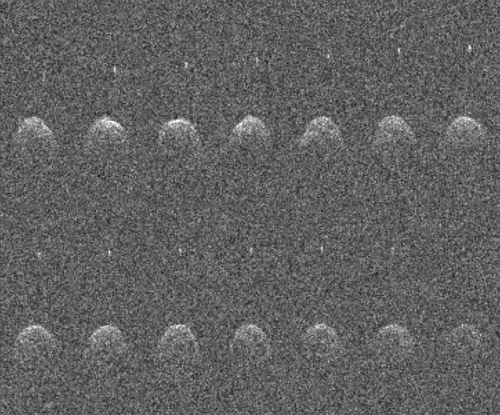Didymos: Difference between revisions
Jump to navigation
Jump to search

Mark Widmer (talk | contribs) (Reforrmatted references) |
Pat Palmer (talk | contribs) (adding an image) |
||
| Line 1: | Line 1: | ||
{{subpages}} | {{subpages}} | ||
{{Image|Didymos-Arecibo-radar-images.png|right|350px|Fourteen sequential Arecibo radar images of the near-Earth asteroid (65803) Didymos and its moonlet Dimorphos, taken on 23, 24 and 26 November 2003.}} | |||
The [[asteroid]] '''Didymos''' and its smaller, satellite asteroid [[Dimorphos]] comprise a binary asteroid system within the [[solar system]]. Didymos was discovered in 1996, and is estimated to contain roughly 99% of the mass of the Didymos-Dimorphos system.<ref name=solarsys_nasa/><ref name=johnston/> | The [[asteroid]] '''Didymos''' and its smaller, satellite asteroid [[Dimorphos]] comprise a binary asteroid system within the [[solar system]]. Didymos was discovered in 1996, and is estimated to contain roughly 99% of the mass of the Didymos-Dimorphos system.<ref name=solarsys_nasa/><ref name=johnston/> | ||
Revision as of 17:45, 13 June 2022
The asteroid Didymos and its smaller, satellite asteroid Dimorphos comprise a binary asteroid system within the solar system. Didymos was discovered in 1996, and is estimated to contain roughly 99% of the mass of the Didymos-Dimorphos system.[1][2]
Properties
Didymos has a mass of 500 to 600 billion kilograms. It is roughly spherical in shape, with an approximate diameter of 780 meters (slightly less than half a mile), and rotates once about its axis about every 2.3 hours.
Didymos orbits the Sun in an elliptical orbit, with a nearest and farthest distance from the sun of about 1 AU and about 2.3 AU, respectively. It orbits the Sun every 2.1 years.
